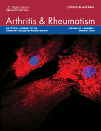Correlation of interferon-inducible chemokine plasma levels with disease severity in systemic sclerosis
Abstract
Objective
To measure interferon (IFN)–inducible chemokines in the plasma of patients with systemic sclerosis (SSc) and investigate whether the chemokine levels are correlated with disease severity.
Methods
Plasma levels of the IFN-inducible chemokines IFNγ-inducible protein 10 (IP-10/CXCL10), IFN-inducible T cell α chemoattractant (I-TAC/CXCL11), and monocyte chemoattractant protein 1 (CCL2) were measured in SSc patients and examined for correlation with the IFN gene expression signature. A composite IFN-inducible chemokine score was generated for chemokines showing a correlation with the IFN gene signature (IP-10 and I-TAC), and this score was compared between 266 patients with SSc enrolled in the Genetics versus Environment in Scleroderma Outcome Study (GENISOS) cohort and 97 matched control subjects. Subsequently, the correlation between the IFN-inducible chemokine score at baseline and markers of disease severity was assessed. In addition, the course of the IFN-inducible chemokine score over time was examined.
Results
The plasma IFN-inducible chemokine score correlated with the IFN gene expression signature, and this score was higher in SSc patients compared to controls. The IFN-inducible chemokine score was also associated with the absence of anti–RNA polymerase III antibodies and presence of anti–U1 RNP antibodies, but not with disease duration, disease type, or other autoantibodies. The chemokine score correlated with concomitantly obtained scores on the Medsger Severity Index for muscle, skin, and lung involvement in SSc, as well as the forced vital capacity, diffusing capacity for carbon monoxide, and creatine kinase levels. The association of the chemokine score with disease severity was independent of the presence of anti–U1 RNP or other potential confounders (age, sex, ethnicity, disease duration, and treatment with immunosuppressive agents). Finally, there was not a significant change in the IFN-inducible chemokine score over time.
Conclusion
The IFN-inducible chemokine score is a stable serologic marker of a more severe form of SSc and may be useful for risk stratification of patients, regardless of disease type (limited or diffuse) or duration of disease.




